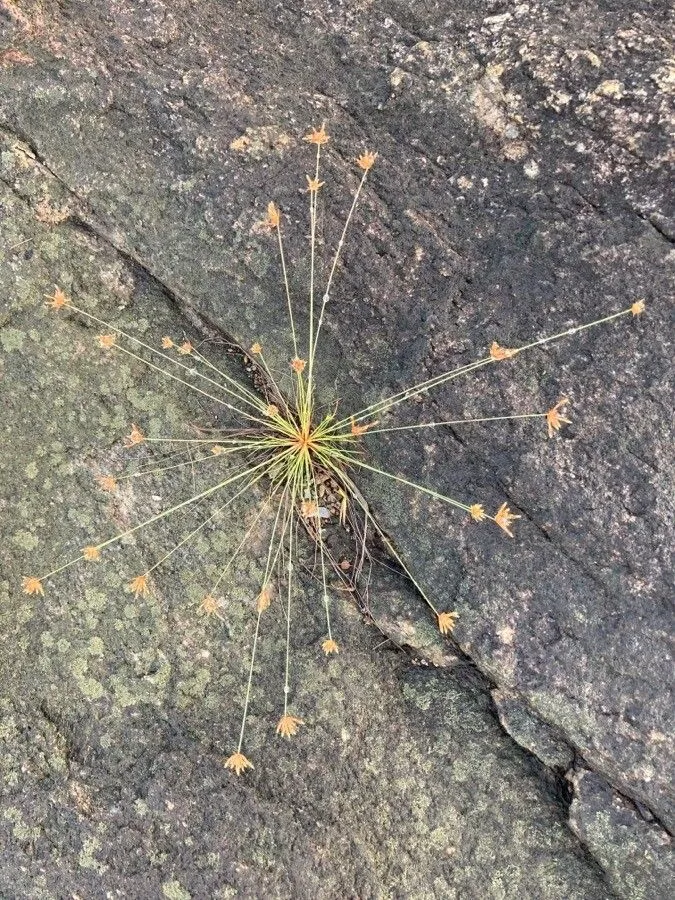
Author: (Rottb.) C.B.Clarke
Bibliography: J.D.Hooker, Fl. Brit. India 6: 651 (1893)
Year: 1893
Status: accepted
Rank: species
Genus: Bulbostylis
Vegetable: False
Observations: Trop. & Subtrop. Old World
Watergrass, with a scientific name of Bulbostylis barbata, is a noteworthy member of the Cyperaceae family. This plant has intrigued botanists and plant enthusiasts alike, largely due to its adaptability and widespread presence across the tropical and subtropical regions of the Old World.
Notably described in “Flora of British India” by J.D. Hooker in 1893, Watergrass has etched its presence in botanical literature for well over a century. The formal taxonomic identification was later attributed to C.B. Clarke, who classified it under its current scientific nomenclature. His pioneering work contributed to the detailed understanding of this species’ morphology and ecological significance.
Bulbostylis barbata thrives in diverse habitats, showcasing a remarkable ability to adapt to various environmental conditions. This resilience and flexibility enable it to colonize and flourish in regions characterized by distinct climatic variables. In the wild, Watergrass often occupies moist grasslands and marshy areas, thriving in its ideal wetland ecosystem.
The plant is easily recognized by its slender, grass-like features. Its growth habit and structural attributes closely resemble those of typical grasses, most notably its fine, hair-like leaves which lend the plant its common name. This resemblance to conventional grass species, however, belies its unique botanical characteristics that set it apart within the Cyperaceae family.
Watergrass plays a vital ecological role in its native habitats. It serves as a crucial component of the plant community, providing food and habitat for a variety of wildlife. Additionally, its robust root system aids in soil stabilization and water retention, beneficial traits for the environments where it is naturally found.
Through the comprehensive field observations and detailed botanical descriptions, the botanical legacy of Watergrass has been cemented in historical and modern botanical studies. Its widespread distribution across the tropical and subtropical regions underscores its environmental versatility and resilience, making it a subject of continued interest for botanists studying plant adaptation and ecosystem dynamics.
Eng: watergrass
En: Watergrass
Fr: Bulbostyle
Taken Mar 12, 2022 by Mayland Muhammad Hanbal (cc-by-sa)
Taken Dec 7, 2021 by Augustin Soulard (cc-by-sa)
Taken Oct 14, 2021 by sachin sharma (cc-by-sa)
Taken Oct 4, 2022 by sachin sharma (cc-by-sa)
Taken Sep 23, 2020 by Shravan Kumbhare (cc-by-sa)
Taken Dec 13, 2021 by Katarzyna Jezierska (cc-by-sa)
© copyright of the Board of Trustees of the Royal Botanic Gardens, Kew.
Growth habit>: Graminoid
Family: Myrtaceae Author: (F.Muell.) K.D.Hill & L.A.S.Johnson Bibliography: Telopea 6: 402 (1995) Year: 1995 Status:…
Family: Rubiaceae Author: Pierre ex A.Froehner Bibliography: Notizbl. Bot. Gart. Berlin-Dahlem 1: 237 (1897) Year:…
Family: Sapindaceae Author: Koidz. Bibliography: J. Coll. Sci. Imp. Univ. Tokyo 32(1): 38 (1911) Year:…
Family: Asteraceae Author: A.Gray Bibliography: Pacif. Railr. Rep.: 107 (1857) Year: 1857 Status: accepted Rank:…
Family: Fabaceae Author: Medik. Bibliography: Vorles. Churpfälz. Phys.-Ökon. Ges. 2: 398 (1787) Year: 1787 Status:…
Family: Aspleniaceae Author: (Cav.) Alston Bibliography: Bull. Misc. Inform. Kew 1932: 309 (1932) Year: 1932…